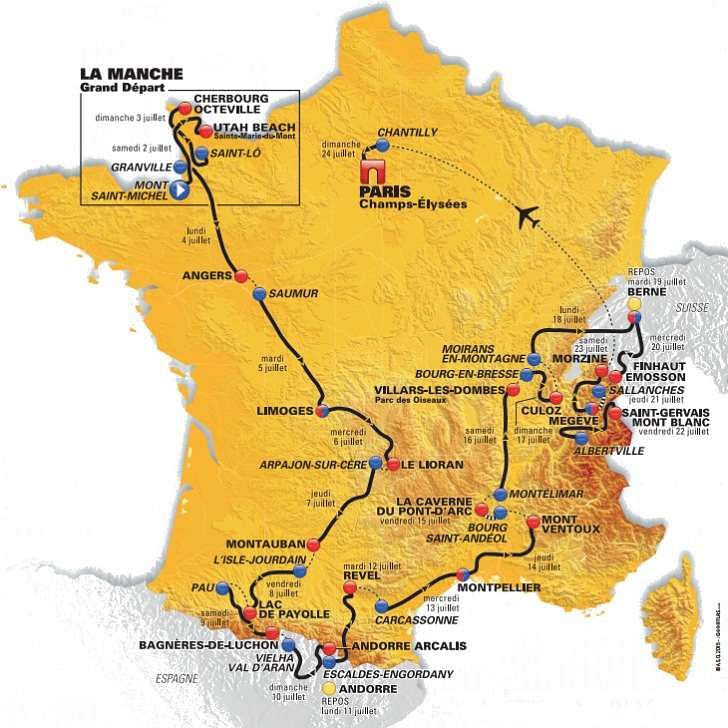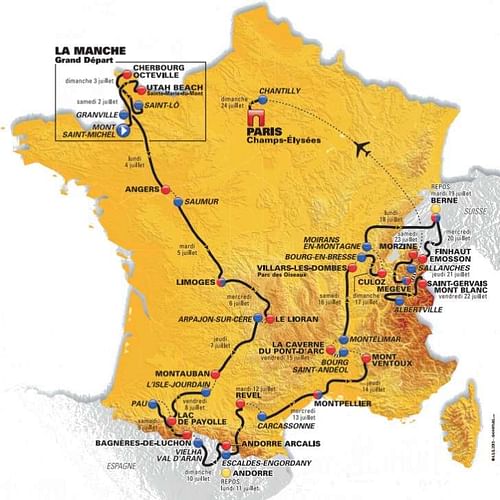
Tour de France 2016: All you need to know about the cycle race
The 103rd Tour de France, the most gruelling cycle race in the world, will start from Mont-Saint-Michel in a matter of hours. So for the uninitiated, here is a quick guide to the world’s most prestigious and physically and mentally tiring race.
#1 The route:
This year’s race will take riders from Mont-Saint-Michel to Paris. The Tour de France is a not entirely correct nomenclature of the race since certain stages also take place in Spain and Swtizerland. Stage 1 will kick-start in Normandy, then move into the Pyrenees, Spain, and Andorra and then turn east into Switzerland and the Alps.
After the penultimate day in the Alps, the riders will embark on the final arduous journey to the finish line in Paris, at the Champs-Elysees.
#2 The teams:
There are a total of 198 riders from 22 teams in this year’s event. The entire swarm of riders is known as the Peloton. Each team has a leader who is the best rider of the team. It is the job of the remaining riders to ensure he can finish as high as possible in the general classification.
The support the team members provide the leader include shelter from inclement weather, quelling the threat posed by rivals, helping him keep his pace up treacherous mountain slopes and keeping him energised with refreshments from the team car which follows at the back of the Peloton. The support squad are known as domestiques.
The defending champions, team Sky, led by Chris Froome are not very difficult to recognise with their all black outfits and they will lead the peloton.
#3 The stages:
The Tour is divided into different stages, according to the topography of the route. There are flat stages and mountain stages, as a broad classification. At the end of the race, only one rider, the winner, shall claim the yellow jersey or maillot jaune, but many riders will have a shot at individual awards during the course of the tour, in different stages.
There are 21 different stages in this year’s tour, and many riders will fancy having a shot at writing their names in the annals of cycling history. Flat stages over the plains have been the forte of sprinters, cyclists who rely on short bursts of speed rather than a constant speed over a prolonged period of time. Mark Cavendish and Marcel Kittel are well known sprinters who are expected to win a lot of the sprint stages.
Flat stage finishes are exciting to watch, as team-mates of well-known sprinters form a convoy akin to a ‘high speed train’ to ensure their leader finishes first. They hurtle towards the finish line at immense speed, generally 150 metres from the finish line. Occasionally, the Peloton fails to judge the distance between itself, and the lead team, generally one of the lesser teams in the fray, and this gives them a chance to win and grab some of the spotlight.
Mountain stages are suited to climbing specialists who are adept at keeping up a constant rate of pedalling up the narrow slopes of the Alps and Pyrenees. Mountain stages have individual time trial awards for the best individual performances against the clock. The all-round racers, who best negotiate the fast sprints and tiring climbs emerge the ultimate winners.
